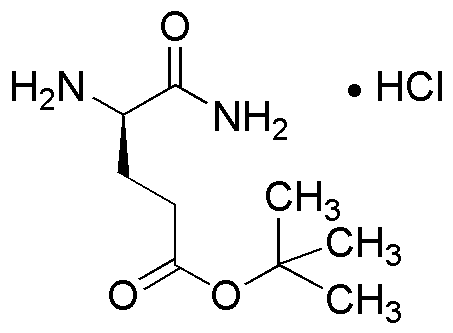D-Glutamic acid g-tert-butyl ester a-amide hydrochloride is widely utilized in research focused on:
- Pharmaceutical Development: This compound serves as a building block in the synthesis of various pharmaceuticals, particularly in the development of neuroprotective agents that target glutamate receptors, which are crucial in treating neurodegenerative diseases.
- Peptide Synthesis: It is commonly used in peptide synthesis, providing a stable and effective way to introduce glutamic acid residues into peptide chains, enhancing their biological activity.
- Biochemical Research: Researchers utilize this compound to study metabolic pathways involving glutamate, helping to understand its role in cellular signaling and metabolism, which is vital for developing treatments for metabolic disorders.
- Food Industry: The compound can be explored as a flavor enhancer or additive, particularly in products aimed at improving umami taste, appealing to food scientists and manufacturers looking for natural alternatives.
- Cosmetic Formulations: Its properties make it suitable for use in cosmetic products, particularly in formulations aimed at skin hydration and repair, appealing to cosmetic chemists focused on innovative skincare solutions.
General Information
Properties
Safety and Regulations
Applications
D-Glutamic acid g-tert-butyl ester a-amide hydrochloride is widely utilized in research focused on:
- Pharmaceutical Development: This compound serves as a building block in the synthesis of various pharmaceuticals, particularly in the development of neuroprotective agents that target glutamate receptors, which are crucial in treating neurodegenerative diseases.
- Peptide Synthesis: It is commonly used in peptide synthesis, providing a stable and effective way to introduce glutamic acid residues into peptide chains, enhancing their biological activity.
- Biochemical Research: Researchers utilize this compound to study metabolic pathways involving glutamate, helping to understand its role in cellular signaling and metabolism, which is vital for developing treatments for metabolic disorders.
- Food Industry: The compound can be explored as a flavor enhancer or additive, particularly in products aimed at improving umami taste, appealing to food scientists and manufacturers looking for natural alternatives.
- Cosmetic Formulations: Its properties make it suitable for use in cosmetic products, particularly in formulations aimed at skin hydration and repair, appealing to cosmetic chemists focused on innovative skincare solutions.
Documents
Safety Data Sheets (SDS)
The SDS provides comprehensive safety information on handling, storage, and disposal of the product.
Product Specification (PS)
The PS provides a comprehensive breakdown of the product’s properties, including chemical composition, physical state, purity, and storage requirements. It also details acceptable quality ranges and the product's intended applications.
Certificates of Analysis (COA)
Search for Certificates of Analysis (COA) by entering the products Lot Number. Lot and Batch Numbers can be found on a product’s label following the words ‘Lot’ or ‘Batch’.
Numéro de catalogue
Numéro de lot/série
Certificates Of Origin (COO)
This COO confirms the country where the product was manufactured, and also details the materials and components used in it and whether it is derived from natural, synthetic, or other specific sources. This certificate may be required for customs, trade, and regulatory compliance.
Numéro de catalogue
Numéro de lot/série
Safety Data Sheets (SDS)
The SDS provides comprehensive safety information on handling, storage, and disposal of the product.
DownloadProduct Specification (PS)
The PS provides a comprehensive breakdown of the product’s properties, including chemical composition, physical state, purity, and storage requirements. It also details acceptable quality ranges and the product's intended applications.
DownloadCertificates of Analysis (COA)
Search for Certificates of Analysis (COA) by entering the products Lot Number. Lot and Batch Numbers can be found on a product’s label following the words ‘Lot’ or ‘Batch’.
Numéro de catalogue
Numéro de lot/série
Certificates Of Origin (COO)
This COO confirms the country where the product was manufactured, and also details the materials and components used in it and whether it is derived from natural, synthetic, or other specific sources. This certificate may be required for customs, trade, and regulatory compliance.


